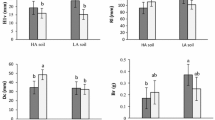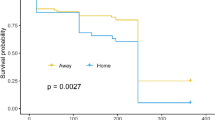Abstract
Seed transfer regulation in forest trees is to prevent the plantation of maladapted trees in non-local sites. Seed transfer from southern to northern Japan is prohibited in Japanese red pine (Pinus densiflora). To evaluate the current regulation of seed transfer, a reciprocal transplant trial was conducted in P. densiflora trees originating from two provenances in southern (S) and northern (N) Japan and planted in sites S and N near these provenances. We observed survival rate at 0–15 years old before a thinning and at 15–30 and 15–40 years old after the thinning and measured diameter, per-planted-area cross-sectional area, and shape of stems of 30-year-old trees. The survival rate before the thinning was lower in provenance S than in provenance N and in site S than in site N. The survival rates after the thinning were lower in non-home sites, in particular, provenance S in site N. The stem diameter was largest in provenance S in site S, smallest in the both provenances in site N, and intermediate in provenance N in site S. Thus, trees were fewer and larger in provenance S than in provenance N in their home sites. As a result, the per-planted-area stem cross-sectional area of 30-year-old trees was smallest in provenance S in site N, suggesting a disadvantage of northward transplantation. Proportions of trees with broken and/or crooked stems were higher in site N than in site S, suggesting that a northern environment is more stressful. These findings support the current regulation of seed transfer directions in Japanese P. densiflora.



Similar content being viewed by others
References
Aitken SN, Yeaman S, Holiday JA, Wang T, Curtis-McLane S (2008) Adaptation, migration or extirpation: climate change outcomes for tree populations. Evol Appl 1:95–111
Bennington CC, Fetcher N, Vavrek MC, Shaver GR, Cummings KJ, McGraw JB (2012) Home site advantage in two long-lived arctic plant species: results from two 30-year reciprocal transplant studies. J Ecol 100:841–851
Breed MF, Stead MG, Ottewell KM, Gardner MG, Lowe AJ (2012) Which provenance and where? Seed sourcing strategies for revegetation in a changing environment. Conserv Genet 14:1–10
Gapare WJ, Baltunis BS, Ivković M, Low CB, Jefferson P, Wu HX (2010) Performance differences among ex situ native-provenance collections of Pinus radiata D. Don. 1: potential for infusion into breeding populations in Australia and New Zealand. Tree Genet Genomics 7:409–419
Howe GT, Aitken SN, Neale DB, Jermstad KD, Wheeler NC, Chen THH (2003) From genotype to phenotype: unraveling the complexities of cold adaptation in forest trees. Can J Bot 81:1247–1266
Ishizuka W, Goto S (2012) Modeling intraspecific adaptation of Abies sachalinensis to local altitude and responses to global warming, based on a 36-year reciprocal transplant experiment. Evol Appl 5:229–244
Iwaizumi MG, Takahashi M, Isoda K, Austerlitz F (2013a) Consecutive multiple-year analysis of paternal and maternal gene flow and contributions of the gametic heterogeneities to overall genetic composition of Pinus densiflora dispersed seeds. Am J Bot 100:1896–1904
Iwaizumi MG, Tsuda Y, Ohtani M, Tsumura Y, Takahashi M (2013b) Recent distribution changes affect geographic clines in genetic diversity and structure of Pinus densiflora natural populations in Japan. For Ecol Manag 304:407–416
Kawecki TJ, Ebert D (2004) Conceptual issues in local adaptation. Ecol Lett 7:1225–1241
Kremer A, Ronce O, Robledo-Arnuncio JJ, Guillaume F, Bohrer G, Nathan R, Bridle JR et al (2012) Long-distance gene flow and adaptation of forest trees to rapid climate change. Ecol Lett 15:378–392
Kreyling J, Wiesenberg GLB, Thiel D, Wohlfart C, Huber G, Walter J, Jentsch J et al (2012) Cold hardiness of Pinus nigra Arnold as influenced by geographic origin, warming, and extreme summer drought. Environ Exp Bot 78:99–108
Leimu R, Fischer M (2008) A meta-analysis of local adaptation in plants. PLoS One 3:e4010
Lin Y, Yang H, Ivković M, Colin GWJ, Matheson A, Wu HX (2013) Effect of genotype by spacing interaction on radiata pine genetic parameters for height and diameter growth. For Ecol Manag 304:204–211
Liziniewicz M, Ekö PM, Agestam E (2012) Effect of spacing on 23-year-old lodgepole pine (Pinus contorta Dougl. var. latifolia) in southern Sweden. Scand J For Res 26:361–371
Mamiya Y (1988) History of pine wilt disease in Japan. J Nematol 20:219–226
McKay JK, Christian CE, Harrison S, Rice KJ (2005) “How local is local?” a review of practical and conceptual issues in the genetics of restoration. Restor Ecol 13:432–440
Nagamitsu T, Nagasaka K, Yoshimaru H, Tsumura Y (2013) Provenance tests for survival and growth of 50-year-old Japanese larch (Larix kaempferi) trees related to climatic conditions in central Japan. Tree Genet Genomics 10:87–99
O’Brien EK, Krauss SL (2010) Testing the home-site advantage in forest trees on disturbed and undisturbed sites. Restor Ecol 18:359–372
Petit RJ, Hampe A (2006) Some evolutionary consequences of being a tree. Ann Rev Ecol Evol Syst 37:187–214
R Core Team (2013) R: A language and environment for statistical computing. R Foundation for Statistical Computing, Vienna, Austria. http://www.R-project.org/
Rehfeldt GE, Ying CC, Spittlehouse DL, Hamilton DA (1999) Genetic responses to climate in Pinus contorta: niche breadth, climate change, and reforestation. Ecol Monogr 69:375–407
Rehfeldt GE, Tchebakova NM, Parfenova YI, Wykoff WR, Kuzmina NA, Milyutin LI (2002) Intraspecific responses to climate in Pinus sylvestris. Glob Chang Biol 8:912–929
Reich PB, Oleksyn J (2008) Climate warming will reduce growth and survival of Scots pine except in the far north. Ecol Lett 11:588–597
Salmela MJ, Cavers S, Wachowiak W, Cottrell JE, Iason GR, Ennos RA (2010) Understanding the evolution of native pinewoods in Scotland will benefit their future management and conservation. Forestry 83:535–545
Savolainen O, Pyhäjärvi T, Knürr T (2007) Gene flow and local adaptation in trees. Ann Rev Ecol Evol Syst 38:595–619
Tateishi M, Kumagai T, Suyama Y, Hiura T (2010) Differences in transpiration characteristics of Japanese beech trees, Fagus crenata, in Japan. Tree Physiol 30:748–760
Toda T, Tajima M, Nishimura K, Takeuchi H (1993) Resistance breeding to the pine wood nematode in Kyushu district: progress of study after selection of the resistant clones. Bull For Tree Breed Inst 11:37–87
Uemura S (1989) Snowcover as a factor controlling the distribution and speciation of forest plants. Plant Ecol 82:127–137
Verhoeven KJF, Macel M, Wolfe LM, Biere A (2011) Population admixture, biological invasions and the balance between local adaptation and inbreeding depression. Proc Biol Sci R Soc 278:2–8
White TL, Adams WT, Neale DB (2007) Forest genetics. CABI Publishing, Cambridge
Willi Y, Van Buskirk J, Schmid B, Fischer M (2007) Genetic isolation of fragmented populations is exacerbated by drift and selection. J Evol Biol 20:534–542
Working Group on Breeding for Wood Properties (1969) Studies on breeding for wood properties in Akamatsu (Pinus densiflora Sieb. et Zucc.) I. Assessment of wood properties of Akamatsu from Tohoku district. Bull Gov For Exp Station 222:1–113
Working Group on Breeding for Wood Properties (1972) Studies on breeding for wood properties in Akamatsu (Pinus densiflora Sieb. et Zucc.) II. Assessment of wood properties of Akamatsu from the Kansai district. Bull Gov Forest Exp Station 244:17–114
Working Group on Breeding for Wood Properties (1989) Studies on breeding for wood properties in Akamatsu (Pinus densiflora Sieb. et Zucc.) III. Open-pollinated families from Iwate experiment station. Bull Gov Forest Exp Station 355:1–158
Wright SJ, Kitajima K, Kraft NJB, Reich PB, Wright IJ, Bunker DE, Condit R et al (2010) Functional traits and the growth-mortality trade-off in tropical trees. Ecology 91:3664–3674
Wu HX, Ying CC (2004) Geographic pattern of local optimality in natural populations of lodgepole pine. For Ecol Manag 194:177–198
Ying CC, Yanchuk AD (2006) The development of British Columbia’s tree seed transfer guidelines: purpose, concept, methodology, and implementation. For Ecol Manag 227:1–13
Acknowledgments
We thank the staff of the Hiroshima and Iwate District Forest Offices for their efforts to maintain the test sites; Keiko Kitamura, Kana Yamashita, Ikuo Karube, Tatsuo Kanazashi, and Hiroshi Yoshimaru for their assistance in field measurement; and Takateru Akashi for his help in data arrangement. We are grateful to Susumu Goto and Masakazu G. Iwaizumi for helpful comments to our manuscript.
Data archiving statement
We deposited phenotypic data of the measurements in all plots in the southern and northern sites to the accession number TGDR036 in the TreeGenes Database.
Author information
Authors and Affiliations
Corresponding author
Additional information
Communicated by J. Beaulieu
Electronic supplementary material
Below is the link to the electronic supplementary material.
Supplemental Material 1
Relationships between stem diameter of progeny trees and stem diameter (a) and year-ring breadth (b) of maternal trees in southern site and those (c, d) in northern site. Open and closed circles indicate provenances S and N, respectively. (PDF 182 kb)
Supplemental Material 2
Seasonal changes in climate conditions at meteorological observatories near southern (red) and northern (blue) sites: Daily records of mean (a), maximum (b), and minimum (c) temperature, precipitation (d), sunshine (e), mean (f) and maximum (g) wind speed, and snow depth (h). Records are averaged for past 30 (a, b, c, d, e, h) and 10 (f, g) years. Snow depth is not recorded in southern observatory due to little snowfall. (PDF 282 kb)
Rights and permissions
About this article
Cite this article
Nagamitsu, T., Shimada, Ki. & Kanazashi, A. A reciprocal transplant trial suggests a disadvantage of northward seed transfer in survival and growth of Japanese red pine (Pinus densiflora) trees. Tree Genetics & Genomes 11, 813 (2015). https://doi.org/10.1007/s11295-014-0813-2
Received:
Revised:
Accepted:
Published:
DOI: https://doi.org/10.1007/s11295-014-0813-2




